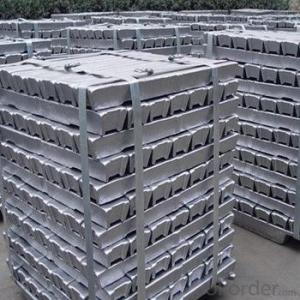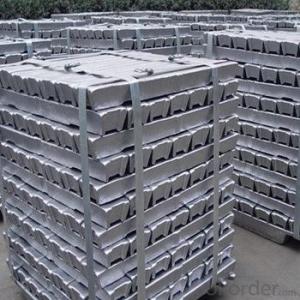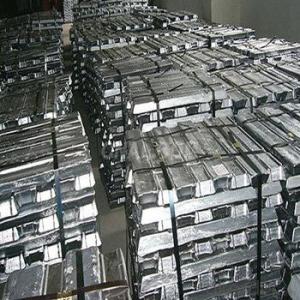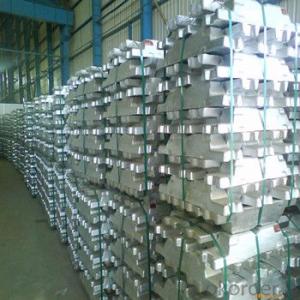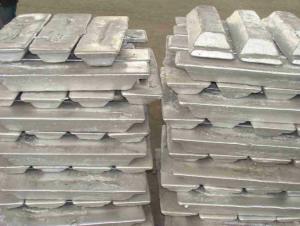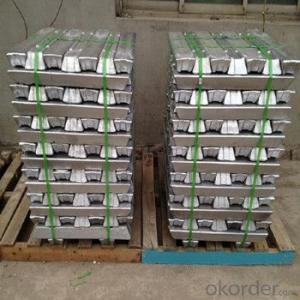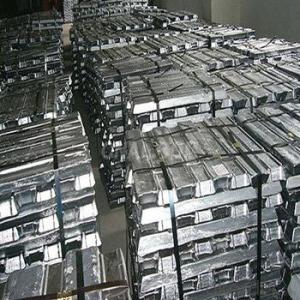Aluminum Pig/Ingot With Grades And Purity For Choice
- Loading Port:
- China main port
- Payment Terms:
- TT OR LC
- Min Order Qty:
- 1000 m.t.
- Supply Capability:
- 100000 m.t./month
OKorder Service Pledge
OKorder Financial Service
You Might Also Like
Pure Aluminum Pig/Ingot Used for Industry
1.Structure of Aluminum Pig/Ingot
A material that has been cast into a shape in order to be transported and processed easier than in an unprocessed form. An ingot is typically rectangular in shape, which allows it to be stacked. Ingots are most commonly associated with metals, with ingots of gold held in the vaults of banks and brokerages being popular images.
Aluminum Ingot is with the AL as the main chemical composition.Aluminum Ingot is used for industry,such as automobile,pinning and weaving,electron broadly and so on. Aluminum Ingot has the following advantages: easy control and operation, fast melting.
2.Main Features of the Aluminum Pig/Ingot
•High Purity
•Easy control and operation
•High strength
•Fast melting
•Competitive price
•Best Service
3.Aluminum Pig/Ingot Images


4.Aluminum Pig/Ingot Specification
Grade | Chemical Composition % | |||||||||
Al≥ | impurities ≤ | |||||||||
Si | Fe | Cu | Ga | Mg | Zn | Mn | others | Sum | ||
Al99.9 | 99.90 | 0.50 | 0.07 | 0.005 | 0.02 | 0.01 | 0.025 | - | 0.010 | 0.10 |
Al99.85 | 99.85 | 0.80 | 0.12 | 0.005 | 0.03 | 0.02 | 0.030 | - | 0.015 | 0.15 |
Al99.7 | 99.70 | 0.10 | 0.20 | 0.010 | 0.03 | 0.02 | 0.030 | - | 0.030 | 0.30 |
Al99.6 | 99.60 | 0.16 | 0.25 | 0.010 | 0.03 | 0.03 | 0.030 | - | 0.030 | 0.40 |
Al99.5 | 99.50 | 0.22 | 0.30 | 0.020 | 0.03 | 0.05 | 0.050 | - | 0.030 | 0.50 |
Al99.00 | 99.00 | 0.42 | 0.50 | 0.020 | 0.03 | 0.05 | 0.050 | - | 0.050 | 1.00 |
5.FAQ of Aluminum Pig/Ingot
We have organized several common questions for our clients,may help you sincerely:
①How about your company?
A professional factory which foucs on producing the aluminum pig,can meet customers' requiement to the quality and grade.The quality also have been accepted by customer.Already got the good reputation among the customers.It have gotten lot of much experience.The facrtory has the professional Technical Worker and the advanced equipments for production.Beside,it has the profesional teams to operate the whole proess for exporting.OEM service is availble and welcome.The items have beedn exported around the world,and have been acceptable among the customers,and have gotten the good reputation already.No matter from the quality,price and service,can be guaranteed for the cusgtomers.High purity and diffent grade are available.
②How to guarantee the quality of the products?
We have established the international advanced quality management system,every link from raw material to final product we have strict quality test;We resolutely put an end to unqualified products flowing into the market. At the same time, we will provide necessary follow-up service assurance.
③How long can we receive the prod rking days, We will arrange the factory delivery as soon as possible. The pecific time of receiving is related to the state and position of customers.Commonly 7 to 10 working days can be served.
- Q:What is the process for smelting aluminum ingots?
- The process for smelting aluminum ingots involves several steps. First, bauxite ore, which is the primary source of aluminum, is mined and refined to remove impurities. The refined bauxite is then transformed into alumina through a process called the Bayer process. Next, the alumina is mixed with cryolite and other additives in a large electric furnace. This mixture is heated to extremely high temperatures, reaching around 1,800 degrees Celsius. The intense heat causes the alumina to melt and separate into aluminum and oxygen. The molten aluminum is then tapped from the furnace and transferred to a holding furnace or a ladle. During this stage, the aluminum is often alloyed with other metals to enhance its properties. Common alloying elements include magnesium, silicon, copper, and zinc. Once the desired alloy composition is achieved, the molten aluminum is poured into molds to form ingots. These molds are typically made of steel and can vary in size and shape depending on the specific requirements. After the aluminum has solidified and cooled, the ingots are removed from the molds and undergo further processing, such as heat treatment or rolling, to achieve the desired mechanical properties and shape. Overall, the process of smelting aluminum ingots involves mining and refining bauxite, transforming it into alumina, melting the alumina to separate aluminum and oxygen, alloying the molten aluminum, pouring it into molds, and finally processing the solidified ingots to achieve the desired properties.
- Q:How are aluminum ingots used in the production of beverage cans?
- Aluminum ingots are used in the production of beverage cans by being melted down and then rolled into thin sheets. These sheets are then cut into precise sizes and formed into can bodies. The ingots' malleability allows for easy shaping, while their lightweight and corrosion-resistant properties make them ideal for packaging beverages.
- Q:How are defects in aluminum ingots repaired?
- Defects in aluminum ingots can be repaired through various methods depending on the type and severity of the defect. One common method is known as remelting, where the defective ingot is melted down and then cast again to remove any impurities or defects. This process helps to refine the metal and eliminate any defects that were present in the original ingot. Another technique used to repair defects in aluminum ingots is called hot working. This involves heating the ingot to a specific temperature and then subjecting it to mechanical processes such as rolling, forging, or extrusion. Hot working effectively reforms the metal, redistributes the defects, and improves the overall quality of the ingot. In some cases, defects in aluminum ingots can also be repaired through a process called heat treatment. This involves subjecting the ingot to controlled heating and cooling cycles to alter its microstructure and eliminate defects such as cracks or voids. Heat treatment can improve the mechanical properties and structural integrity of the ingot, making it suitable for various applications. Furthermore, defects in aluminum ingots can also be repaired through welding or surface machining. Welding is particularly effective for repairing cracks or fractures in the ingot, while surface machining can remove surface defects such as dents or scratches. It is important to note that the specific repair method employed depends on the nature and extent of the defect, as well as the intended application of the aluminum ingot. Manufacturers and specialists in the field of aluminum production and processing employ various techniques to ensure that defects are effectively repaired, resulting in high-quality aluminum products.
- Q:What aluminum factories are there in Guangdong and Foshan?
- Cheap comparison, if the quality can price in the medium level, but can be at ease, is called a penny goods.
- Q:How can the aluminum factory calculate the cost better?
- It all adds up to the material cost, but does not include the company's operating costs, you like this without basic data are difficult to calculate the accurate data, not one of the costs are not the same, I can't help you.
- Q:The main raw material for aluminum smelting aluminum ingots from which into
- In our country the scrap aluminum recycling, about 1/5 from the packaging industry, the transportation industry from 2/5, 1/3 from the construction industry, recycling scrap cars produce scrap aluminum and aluminum cans are two important fields. China is the world's largest aluminum production and consumption country, with a large number of aluminum products into scrap, scrap recycling domestic future volume will continue to increase, and our dependence on imported scrap will also continue to reduce.
- Q:Can aluminum ingots be anodized?
- Aluminum ingots are capable of undergoing anodization. Anodization, an electrochemical procedure, yields a safeguarding oxide layer on the exterior of aluminum. This technique can be employed on aluminum ingots, sheets, or any other manifestations. Anodization boasts numerous advantages, including heightened resistance against corrosion, enhanced durability, and the potential to introduce color onto the surface. Moreover, the anodized layer enriches the aesthetic appeal of the aluminum and facilitates superior adhesion of paints or dyes. In summary, the anodization of aluminum ingots is a prevalent practice across diverse industries to augment both the properties and appearance of the metal.
- Q:Could you tell me how to calculate the value of aluminum material? By weight or by length or by other means?
- By weight, like steel.Different materials of aluminum and aluminum prices are different, different shapes of the price is not the same.
- Q:How are aluminum ingots used in the production of power transmission towers?
- Aluminum ingots are used in the production of power transmission towers due to their lightweight and high strength properties. These ingots are melted down to create aluminum alloys, which are then cast into various components of the towers such as lattice structures, cross arms, and braces. The lightweight nature of aluminum makes it an ideal material for power transmission towers as it reduces the overall weight of the structure, making it easier and more cost-effective to transport and install. This is particularly advantageous in areas with difficult terrains or remote locations. Moreover, aluminum alloys offer excellent corrosion resistance, ensuring the longevity and durability of the power transmission towers. They can withstand harsh weather conditions, including extreme temperatures, humidity, and exposure to saltwater or chemicals. Additionally, aluminum ingots are highly malleable, allowing for easy fabrication and customization of tower components to meet specific design requirements. This flexibility enables engineers to create intricate lattice structures that can support heavy loads while maintaining stability. Aluminum's electrical conductivity is another key factor in its use for power transmission towers. It allows for efficient transmission of electricity with minimal power loss. This is crucial in maintaining the reliability and efficiency of the power grid. Overall, aluminum ingots play a vital role in the production of power transmission towers by providing lightweight, corrosion-resistant, and electrically conductive materials. Their use contributes to the construction of reliable, durable, and cost-effective infrastructure for transmitting electricity across long distances.
- Q:What is aluminium ingot? Is it different from other series of aluminum?
- This you communicate with manufacturers, stripes can be reduced as much as possible
1. Manufacturer Overview |
|
|---|---|
| Location | |
| Year Established | |
| Annual Output Value | |
| Main Markets | |
| Company Certifications | |
2. Manufacturer Certificates |
|
|---|---|
| a) Certification Name | |
| Range | |
| Reference | |
| Validity Period | |
3. Manufacturer Capability |
|
|---|---|
| a)Trade Capacity | |
| Nearest Port | |
| Export Percentage | |
| No.of Employees in Trade Department | |
| Language Spoken: | |
| b)Factory Information | |
| Factory Size: | |
| No. of Production Lines | |
| Contract Manufacturing | |
| Product Price Range | |
Send your message to us
Aluminum Pig/Ingot With Grades And Purity For Choice
- Loading Port:
- China main port
- Payment Terms:
- TT OR LC
- Min Order Qty:
- 1000 m.t.
- Supply Capability:
- 100000 m.t./month
OKorder Service Pledge
OKorder Financial Service
Similar products
New products
Hot products
Related keywords
